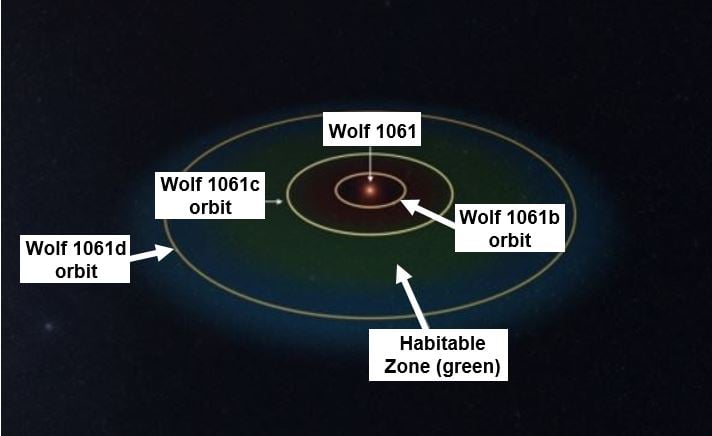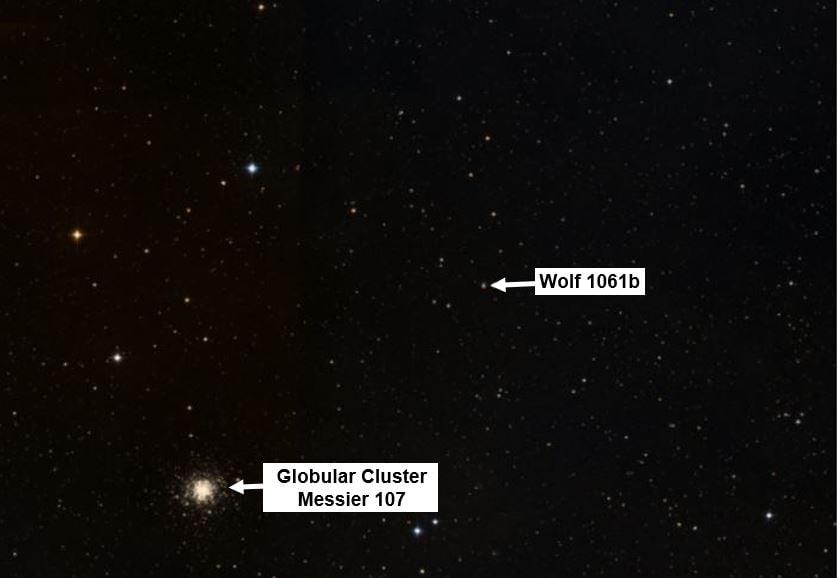A potentially habitable planet really near to us has scientists super excited. The planet – Wolf 1061c – is just 14 light years away, which astronomically-speaking is just a stone’s throw away, says a team of astronomers at the University of New South Wales in Australia.
The exoplanet (planet outside our solar system) orbits a dwarf star called Wolf 1061 (Wolf 1061c is the planet while Wolf 1061 is the star it orbits).
The scientists say their study will be published in the academic journal The Astrophysical Journal Letters.
 Wolf 1061 and its orbiting planets. The habitable zone is shaded green. (Image: newsroom.unsw.edu.au)
Wolf 1061 and its orbiting planets. The habitable zone is shaded green. (Image: newsroom.unsw.edu.au)
Lead author, Dr. Duncan Wright, and colleagues detected three exoplanets orbiting the dwarf star. Wolf 1061c is over four times the mass of the Earth.
Most scientists believe there is life in the Universe (apart from Earth), and some of that life is probably as intelligent as or smarter than we are. However, the scientific community expected that any discovery would be thousands of light years from Earth.
Wolf 1061c is in the ‘Goldilocks Zone’
While all three planets that orbit Wolf 1061 are possibly rocky with a solid surface, Wolf 1061c is the only one in the ‘Goldilocks Zone’. This zone, also known as the Circumstellar Habitable Zone or simply the Habitable Zone, is the region around a star within which a planet could have the temperature, atmospheric pressure, sunlight and liquid water that is ‘just right’ to support life as we know it.
Dr. Wright said:
“It is a particularly exciting find because all three planets are of low enough mass to be potentially rocky and have a solid surface, and the middle planet, Wolf 1061c, sits within the ‘Goldilocks’ zone where it might be possible for liquid water – and maybe even life – to exist.”
“It is fascinating to look out at the vastness of space and think a star so very close to us – a near neighbour – could host a habitable planet. While a few other planets have been found that orbit stars closer to us than Wolf 1061, those planets are not considered to be remotely habitable.”
 The sky area in the constellation of Ophiucus near the red dwarf star Wolf 1061 which includes the impressive, but unrelated, star cluster Messier 104. Wolf 1061 is fourteen light years from Earth. (Image: newsroom.unsw.edu.au. Credit: UNSW/The “Aladin sky atlas”)
The sky area in the constellation of Ophiucus near the red dwarf star Wolf 1061 which includes the impressive, but unrelated, star cluster Messier 104. Wolf 1061 is fourteen light years from Earth. (Image: newsroom.unsw.edu.au. Credit: UNSW/The “Aladin sky atlas”)
Potentially habitable planet orbits a cool star
The three newly-discovered planets orbit Wolf 1061 – a small, relatively cool and stable star – approximately once every 67, 18 and 5 days. Their masses are at least 5.2, 4.3 and 1.4 times that of Earth, respectively.
The largest of the three falls just outside the boundary of the Goldilocks Zone, but is likely to be rocky. The smaller inner planet is too near its star to be habitable.
Dr. Wright and colleagues made their discovery using observations of Wolf 1061 gathered by the HARPS spectrograph on the European Southern Observatory’s (ESO’s) 3.6-metre telescope in La Silla, Chile.
Professor Chris Tinney, head of the Exoplanetary Science at UNSW group, said:
“Our team has developed a new technique that improves the analysis of the data from this precise, purpose-built, planet-hunting instrument, and we have studied more than a decade’s worth of observations of Wolf 1061.”
“These three planets right next door to us join the small but growing ranks of potentially habitable rocky worlds orbiting nearby stars cooler than our Sun.”
Milky Way is full of Earth-like planets
Astronomers and astrophysicists say small, rocky planets like the Earth are abundant in the Milky Way (our galaxy), and multi-planet systems are also common. Nearly all rocky exoplanets found until now are hundreds or thousands of light years away.
If an exoplanet is, for example, ten thousand light years from Earth, anything we detect happened ten thousand years ago. Anything we see on the newly-detected Wolf 1061c happened just 14 years ago.
This latest discovery beats Gliese 667Cc, which is 22 light years from Earth. It orbits its star (red dwarf) every 28 days and it at least 4.5 times as massive as out planet.
Team member Dr. Rob Wittenmyer said:
“The close proximity of the planets around Wolf 1061 means there is a good chance these planets may pass across the face of the star. If they do, then it may be possible to study the atmospheres of these planets in future to see whether they would be conducive to life.”
Video – Close potentially habitable planet
This video contains a simulation of the orbital configuration of the Wolf 1061 system.

